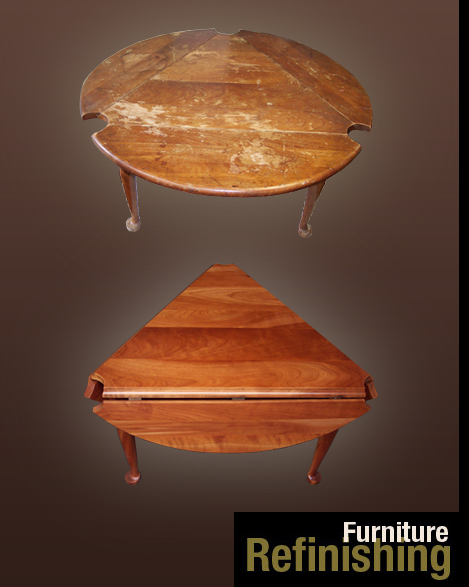Here is another topic, that proves interesting. Let’s start with the types of wood finishes that you may find on your furniture.
Penetrating Finish: If your furniture has an oil finish, you have a penetrating finish. The oil actually penetrates the wood fibers. This type of finish is usually a “teak oil”, “antique oil”, “tung oil”, or even “salad bowl” finish. These are oil based, easy to apply, look “natural” and will not build up a film, will dry hard but are not very durable and spot easily. In order to maintain this type of finish, you will have to reapply the correct oil frequently. “Wipe on, wipe off”. If you don’t, the wood will start to look dry and the wood will take on stains that won’t come out. You can apply a few coats of paste wax over the oil, for a very beautiful finish. However, if you have an active household and don’t want to be constantly worried about maintenance, you should not own a piece of furniture that has an oiled finish. If you already do, use a commercially prepared oil finish and follow the directions. Be sure to take ALL oil soak rags and place them in a plastic bag, soak them with a lot of water, tie the bag shut, and remove them from the house the minute you have completed the oiling.
Surface finishes: This category of finish will include urethane, shellac, varnish, laquer, conversion varnish, catalyzed lacquer, etc. Multiple coats are applied, each one building on the last, sitting on the surface. Although the first coat may penetrate the wood fibers, the succeeding coats do not. They build and encase. Although they have different strengths and will hold up to use in different ways, oil will not pass through them. Water can damage some of these finishes, particularly shellac and nitrocellulose lacquer, leaving white rings or a white haze.
The easiest way to care for this type of finish is to use polish. Try to choose a polish without silicone. I really like Guardsman Furniture Polish. Use a soft cotton cloth. Never use paper towels, this will scratch your finish. I love 100% cotton wash clothes or old fashioned cloth diapers, which you can throw in the wash and reuse. Do not scrub spots (like dried on food) because you will shift the sheen. Instead, soften them with the polish and wipe them away. Do not oil furniture that has this type of finish. It is the equivalent of oiling your windows. It just sits there, on top and not penetrating. It may look nice a shiny at first, but it will evaporate and look awful, while attracting dirt and dust. Do not use citrus based products either. The biggest reason you are using polish is to lock the dust into your rag. The other reason, is that it keeps your rag for abrading the finish. Finally, it does make everything look nice and new again.
Wax: Although wax can be used as a finish, and is beautiful, it is not usual on furniture. (With the exception of antique/country pine.) It is not durable enough to stand up on it’s own, particularly on tops that might have a glass or plant set down on them. It is generally better to use it as a you would use polish, if you have a lot of free time on your hands. Wax imparts a beautiful sheen, so many people like it. Many European antiques have a shellac finish that has been waxed rather then polished.
With wax, there are two important things to know.
First: less is more. If you can see the wax as you apply it, your are applying too much and will spend the rest of your life trying to rub it out. Apply a thin coat, let it dry, and then rub it to a satin sheen. Repeat. Sometimes, repeat again. Once you have a consistent sheen, you shouldn’t have to do this more then once a year, if that. If you see a dull spot, take your clean and soft rag and rub it out again. You may not even need more wax.
Second: If you are waxing walnut, mahogany or any other dark wood, use a dark paste wax. If you are waxing pine or oak, use a light or natural paste wax. Keep in mind that the color you see in the can is the color you will see in recessed openings, deep grain, joints, etc. of your furniture or woodwork. Once you have the wrong color in recessed areas it is extremely difficult to get out.
In summary, the easiest way to care for your furniture is to use a clean and soft cotton rag, a good polish, and a light touch.

- Log in to post comments
